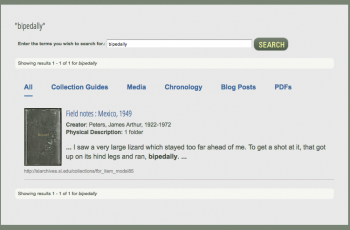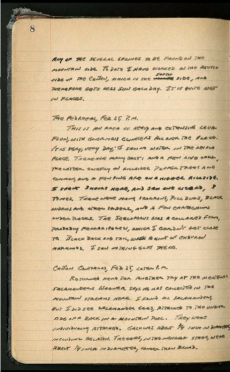Back in 2010, the Smithsonian National Museum of Natural History and the Smithsonian Institution Archives launched the Field Books Project, a joint initiative focused on enriching access to the institution’s collection of field books, notes, images, and journals related to field research. Since then, field books have become a common theme on this blog, as well as popular projects on the Smithsonian Transcription Center. There was just one slight problem:they weren’t searchable on our website. In fact, not only were they not searchable, they weren’t actually anywhere on our website at all.
That recently changed as work was completed that made over 9,000 field book related records available on our website. Those 9,000 records contain collection descriptions, organizations information, collector information, expedition information, and finally the field books themselves. Each of these records contains detailed metadata, which helps our search functionality (and you!) find these field books, much like the large collection of images found on our website. As cool as searching for them by metadata is, the field books contain a lot of information that just won’t show up on a metadata search. To be able to truly search the field books, they really need to be fully text searchable.
Thanks to the contributions by the digital volunteers at the Transcription Center, we are now working on doing just that. As the field books are largely hand written notes, they need to be transcribed into machine-readable text before we can index their content. Once the volunteers at the Transcription Center complete transcribing a field book, we pull the resulting full text and encode it with the field book item on our site. The text is then crawled by our search appliance and indexed with the full text.

 The result is that a search for “bipedally” will return James Peters’ Field notes from his 1949 Mexico trip, as the phrase “I saw a very large lizard which stayed too far ahead of me. To get a shot at it, that got up on its hind legs and ran, bipedally” appears in his entry for March 8, 1949.
The result is that a search for “bipedally” will return James Peters’ Field notes from his 1949 Mexico trip, as the phrase “I saw a very large lizard which stayed too far ahead of me. To get a shot at it, that got up on its hind legs and ran, bipedally” appears in his entry for March 8, 1949.
The really cool thing about all of this is that you can help us with this project and be a part of making our field books searchable and findable. As I mentioned before, none of this would be possible without the work done by the digital volunteers over at the Transcription Center, and they’re always looking for more volunteers.
Related Resources
The Field Book Project: Uncovering Hidden Gems at the Smithsonian, The Bigger Picture, Smithsonian Institution Archives
Growing to a Community of Volunpeers: Communication & Discovery, The Bigger Picture, Smithsonian Institution Archives
Produced by the Smithsonian Institution Archives. For copyright questions, please see the Terms of Use.

Leave a Comment